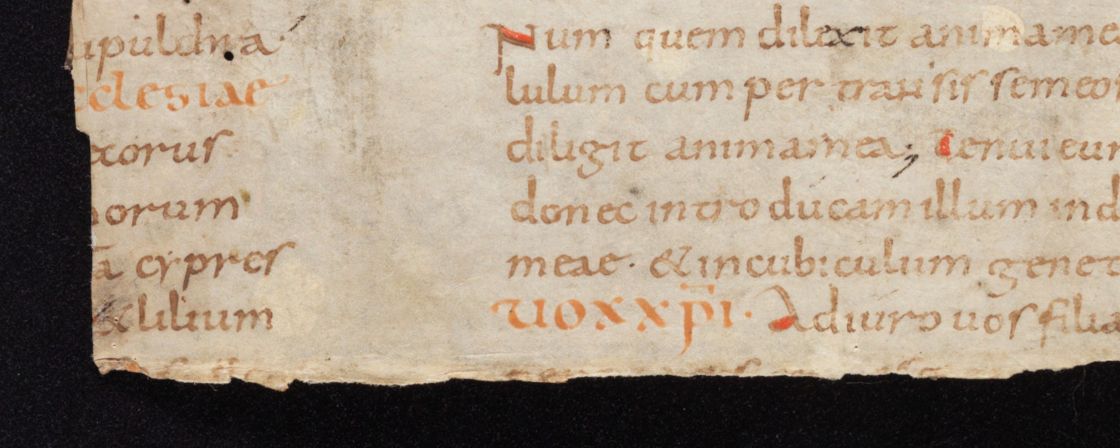|
|

|

|
|
|
|
|
|
|

|
1. St. Gall Abbey - 1000 years of manuscript production
For more than 1000 years, manuscripts were created in St. Gallen. The earliest ones date from the time of Winithar around 760 to 780 (Cod. Sang. 70, 238, 907, among others), the most recent ones are from the second half of the 18th century. Four antiphonaries for the Liturgy of the Hours, created by Father Dominikus Feustlin (1713-1782) between 1757 and 1758, are from the last decades of manuscript production at St. Gallen. Originally laid out in two volumes, they were divided into four volumes under Abbot Beda Angehrn; one volume for each season, i.e. the spring part (Cod. Sang. 1763), the summer part (Cod. Sang. 1764), the autumn part (Cod. Sang. 1795), and the winter part (Cod. Sang. 1762).
|
|
|
|
|
|
|
|

|
2. 79 new manuscript descriptions in 2019
e-codices is a research platform: its most important scholarly contribution is numerous new descriptions, created by leading scholars. So far 540 new descriptions have been written, most of them specifically for e-codices. Last year, a record 79 new scholarly descriptions were added. Most of these descriptions are the result of a specific sub-project, such as the project “Hebrew Manuscript Library of Switzerland”, led by Dr. Justine Isserles (Ecole Pratique des Hautes Etudes-Saprat in Paris), the sub-project “Fragmenta Bongarsiana”, or the project “Codices Fuldenses Helvetiae”, led by Dr. Johannes Staub (Institut Bibliotheca Fuldensis in Fulda).
|
|
|
|
|
|
|
|

|
3. Grenet collection (Lausanne, Bibliothèque cantonale et universitaire, M 1016)
The Grenet collection (“Recueil Grenet”) is a family manuscript conceived by the merchant Gilbert Grenet, bourgeois of Geneva, between 1542 and 1565. It brings together more than 200 poems, anonymous or by famous Protestant writers (Marot, Bèze), from the early days of the Calvinist Reformation to the French Wars of Religion. Partially illuminated and carefully organized, the codex is a remarkable example of the active appropriation of French satirical, moral and polemical poetry by middle-class readers in the 16th century. Unknown until today, the collection is currently being surveyed in SNF-funded research project “Medialiterature. Literary Poetics and Social Uses of Public Communication at the Age of the Orators (c. 15-16)” (Prof. Estelle Doudet, Université de Lausanne).
|
|
|
|
|
|
|
|

|
4. Two new collections: Historisches Museum Thurgau and Fondation Barbier-Mueller pour l’étude de la poésie italienne de la Renaissance (Université de Genève)
e-codices contains manuscripts from libraries, archives, museums and private collections. Two more museums are now providing public access to their treasures through digital publication. The Historisches Museum Thurgau in Frauenfeld serves as the museum of the canton’s history, and as such it maintains extensive collections, including several illuminated manuscript fragments, so-called “cuttings”. The Fondation Barbier-Mueller pour l’étude de la poésie italienne de la Renaissance (Université de Genève) was created by Jean-Paul Barbier-Mueller, the famous collector of primitive arts. From his collection of Italian Renaissance texts, e-codices published a composite manuscript by the Florentine poet Gabriele Simeoni and Giovanni Battista Strozzi.
|
|
|
|
|
|

|
5. sine loco – fragments of an Alcuin Bible from various Swiss libraries
“sine loco” is a virtual collection containing reconstructed manuscripts, so-called “Codices restituti”; these manuscripts are reconstructed from fragments held in different locations. An attempt is being made to restore the original state of the manuscript as well and as completely as possible, based on the surviving documents. The most recent reconstruction contains fragments of an Alcuin Bible; the fragments are from the Berner Burgerbibliothek, the Zentralbibliothek Solothurn, and the Universitätsbibliothek Bern. Recent research has shown that more fragments are held by the Universitätsbibliothek Basel.
|
|
|
|
|
|
|
|













